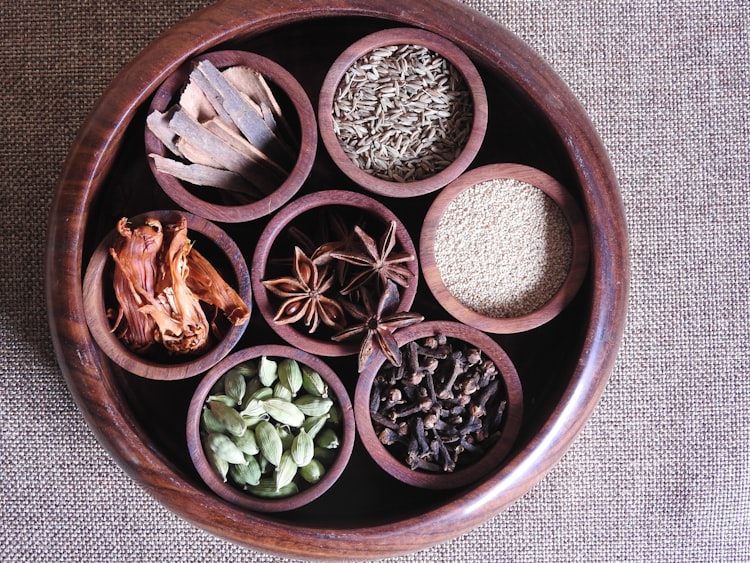Nepalese Gastronomy

Nepal's gastronomy not only combines the many people groups that merged to form the nation of Nepal, but balances the overpowering influence of Tibet and India. The cuisine is closely tied to the highs and lows of the Himalayan geography. The result is a blend of earthy flavors and textures that reflect the country's diverse cultural heritage and natural resources.
Culture and Geography
History
Nepalese cuisine is influenced by the country's diverse culture, history, and geography. The cuisine has been shaped by the influences of neighboring countries like India, Tibet, and China, as well as by the country's indigenous traditions.
One of the biggest cultural influences on Nepalese food is Indian cuisine. The use of spices and herbs in Nepalese cooking, such as cumin, coriander, turmeric, and chili, is a clear influence of Indian cooking. Similarly, the use of lentils, vegetables, and rice as staples in Nepalese cuisine is also an influence from Indian cooking.
Another significant influence on Nepalese cuisine comes from Tibet. Tibetan food has a strong emphasis on meat and dairy products, which can be seen in Nepalese dishes such as Yak meat and butter tea. Additionally, Tibetan momos, which are steamed or fried dumplings, are a popular street food in Nepal. Similarly, the close proximity of Nepal to China has also resulted in a Chinese influence on Nepalese cuisine.
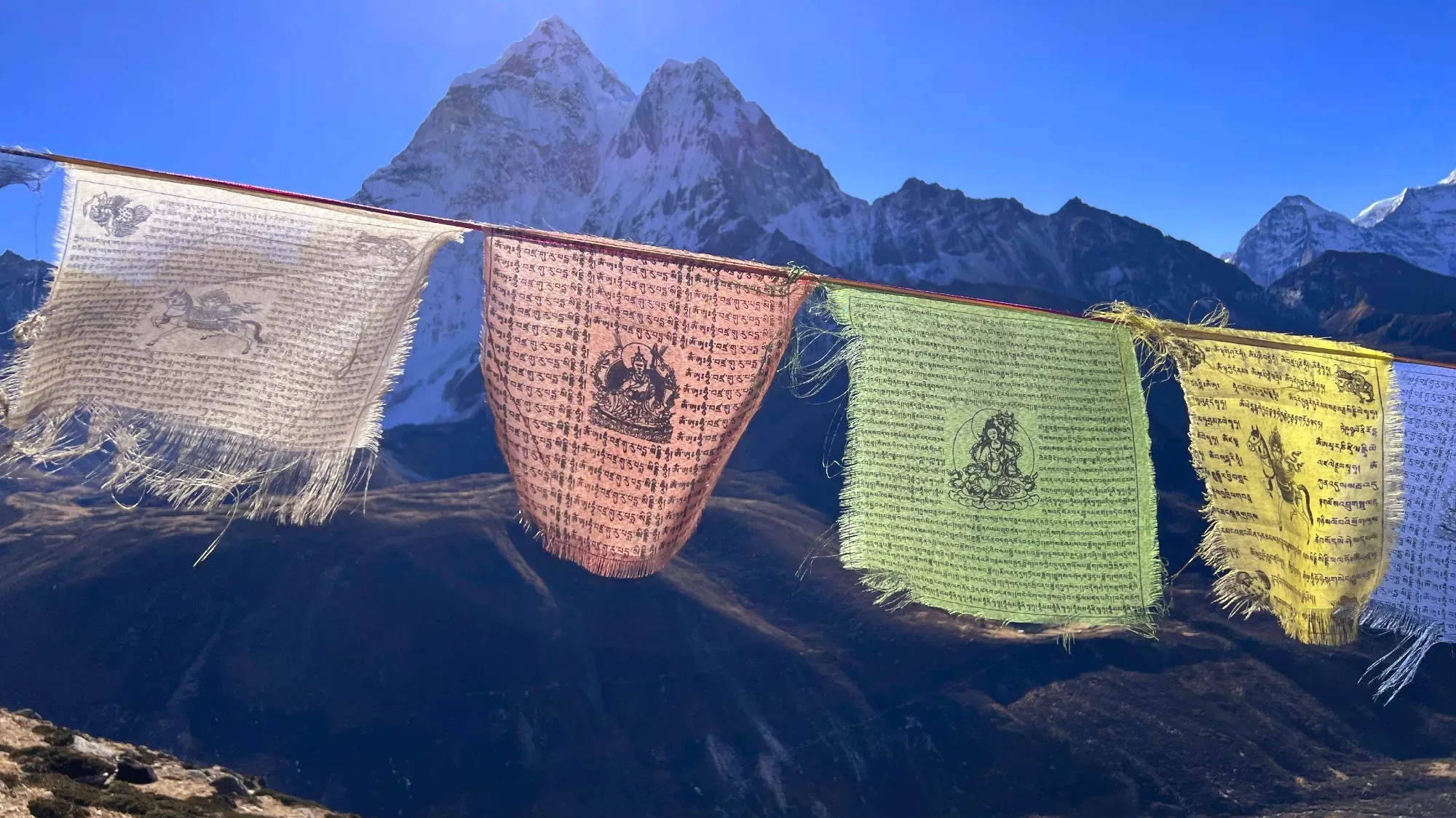
Regions
Nepalese cuisine varies greatly across different regions due to the country's diverse geography and agriculture. The southern Terai region has a tropical climate, making it ideal for growing rice, lentils, and vegetables. As a result, Terai cuisine is heavily influenced by Indian cooking, with spicy curries and vegetable dishes being popular.
The hilly regions of Nepal have a temperate climate, and the cuisine here is characterized by dishes made with locally grown produce such as millet, maize, and buckwheat. The staple food in the hills is Dal Bhat, but with different varieties of lentils, such as black or green lentils. The hills also have a significant Tibetan influence, resulting in dishes such as Thukpa, a noodle soup.
The mountainous regions of Nepal have a cold climate, which makes it difficult to grow crops. As a result, the cuisine here is heavily reliant on meat, particularly yak and goat, and dairy products like butter and cheese. Dishes such as Sherpa Stew and Chhurpi are popular in this region.
Ingredients
Nepalese cuisine features a wide range of ingredients that reflect the country's diverse geography and cultural influences. Some of the most commonly used ingredients in Nepalese cuisine include:
Vegetables: A variety of vegetables are used in Nepalese cuisine, including potatoes, cauliflower, spinach, peas, beans, pumpkin, eggplant, and tomatoes. Many of these vegetables are used in curries and stews and are often combined with spices to create flavorful dishes.
Meats/Fish: Meat plays a prominent role in Nepalese cuisine, with chicken, goat, and buffalo being the most commonly consumed meats. Yak meat is also popular in the mountainous regions of Nepal. Fish is sometimes consumed in Nepal, with river fish being more commonly consumed than ocean fish.
Carbs: Rice is the staple food of Nepal, and it is often served with lentil soup, vegetables, and meat. Breads, such as roti and naan, are also common, especially in the Terai region. Noodles, such as Chowmein, are also popular and are often stir-fried with vegetables and meat.
Herbs/Spices: Nepalese cuisine is known for its bold and spicy flavors, which are achieved through the use of a variety of herbs and spices. Commonly used spices include cumin, coriander, turmeric, chili, and garlic. Ginger is also widely used, especially in tea. A range of herbs such as coriander, mint, and basil are also used to add freshness to dishes.
Condiments/Sauces: A variety of sauces and condiments are used in Nepalese cuisine, such as chutneys made with tomatoes, cilantro, and mint. Tomato sauce and tamarind sauce are also popular. Mustard oil is a common cooking oil in Nepal and is often used to add flavor to dishes.
Major Ingredients
Lentils
Yak
Potato
International Highlights
Dal Bhat
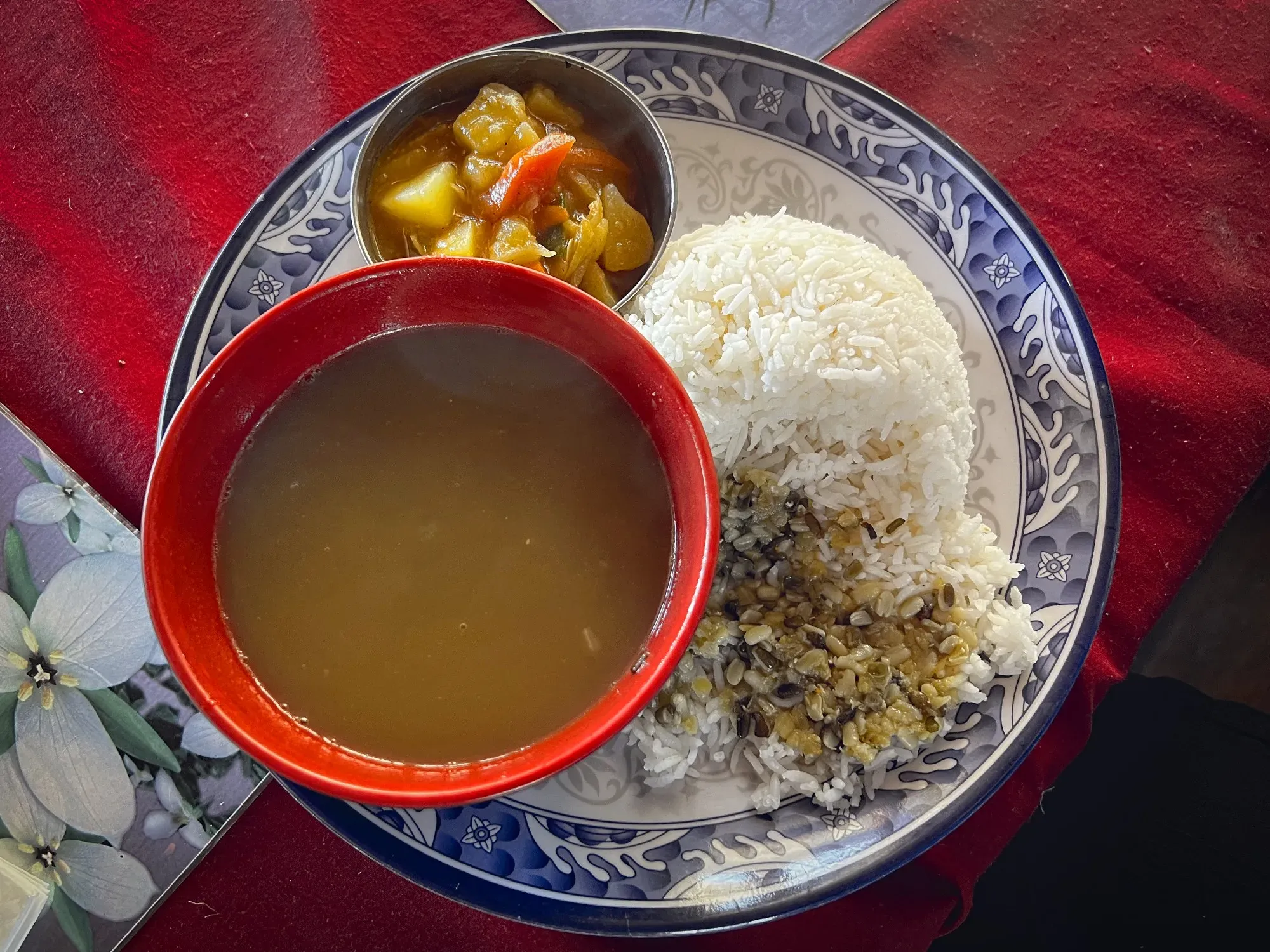
Dal Bhat is the national dish of Nepal and is a staple food in the country. It consists of two main components, dal, a soup made with lentils, and bhat, boiled rice. The dish is usually served with vegetable curries, pickles, and sometimes meat.
The origin of Dal Bhat can be traced back to the Indian subcontinent, where it has been a staple food for centuries. The dish was introduced to Nepal through cultural and trade connections with India, and over time it has become an integral part of Nepalese cuisine.
Dal Bhat is not only popular in Nepal but also in other South Asian countries such as India, Bangladesh, and Pakistan. It is a nutritious and filling meal that provides a good balance of carbohydrates and protein, making it a favorite of trekkers and mountaineers in the Himalayan region.
Dal Bhat is also an important part of Nepalese culture and tradition. It is often served at festivals, weddings, and other celebrations, and is a symbol of hospitality and generosity. The dish has also become a symbol of national identity, and is cherished by Nepalese people both at home and abroad.
Momo
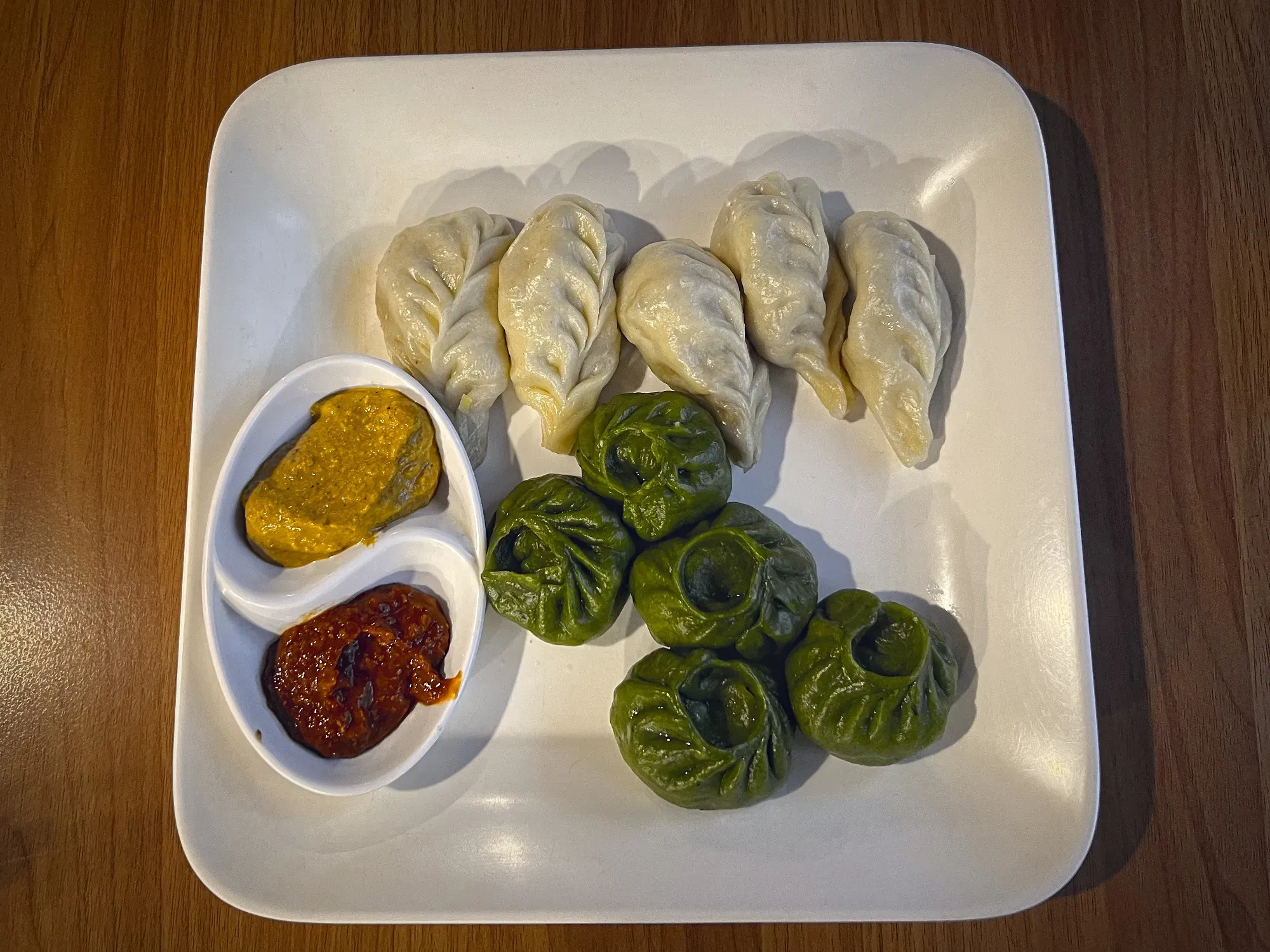
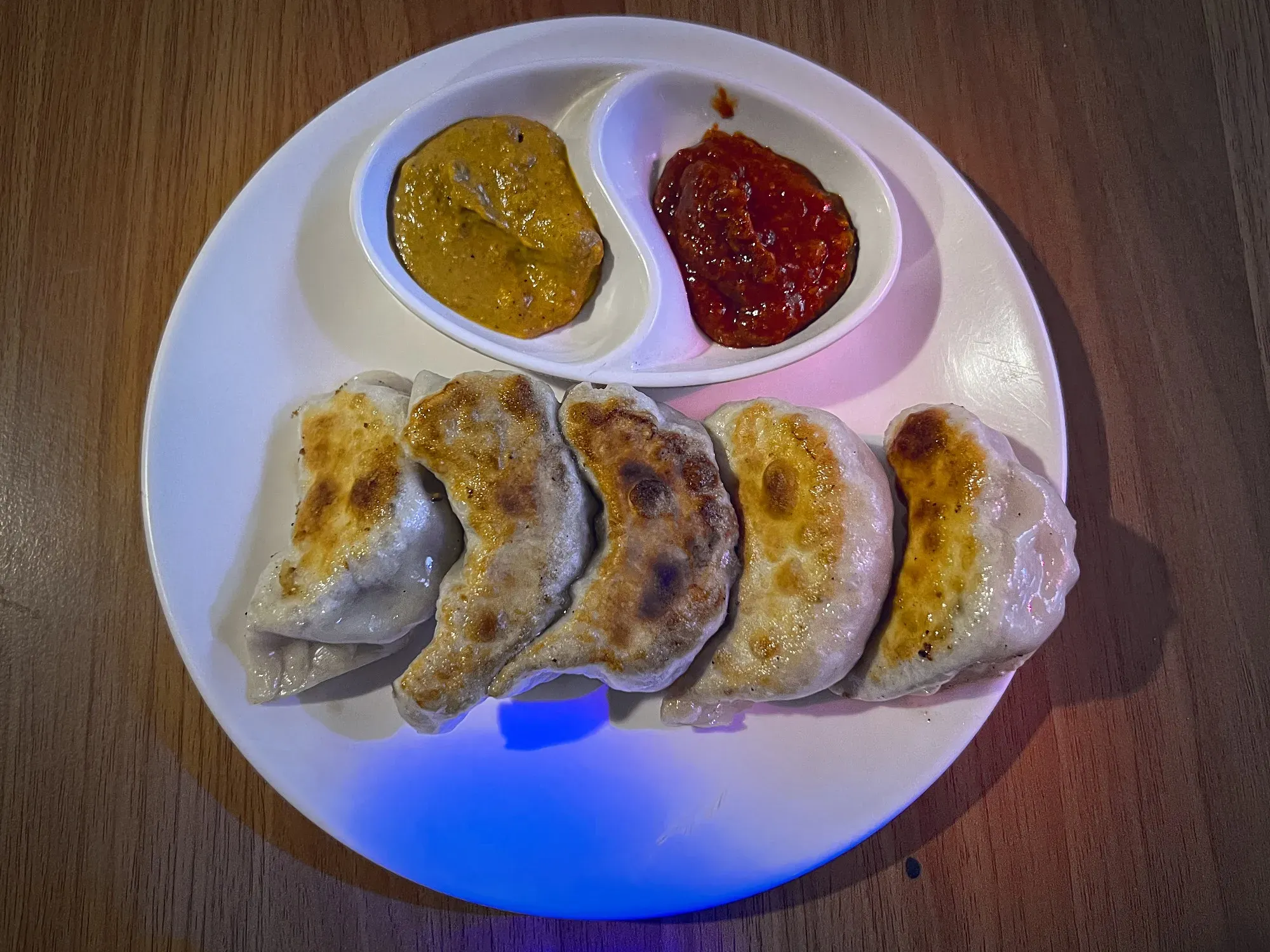
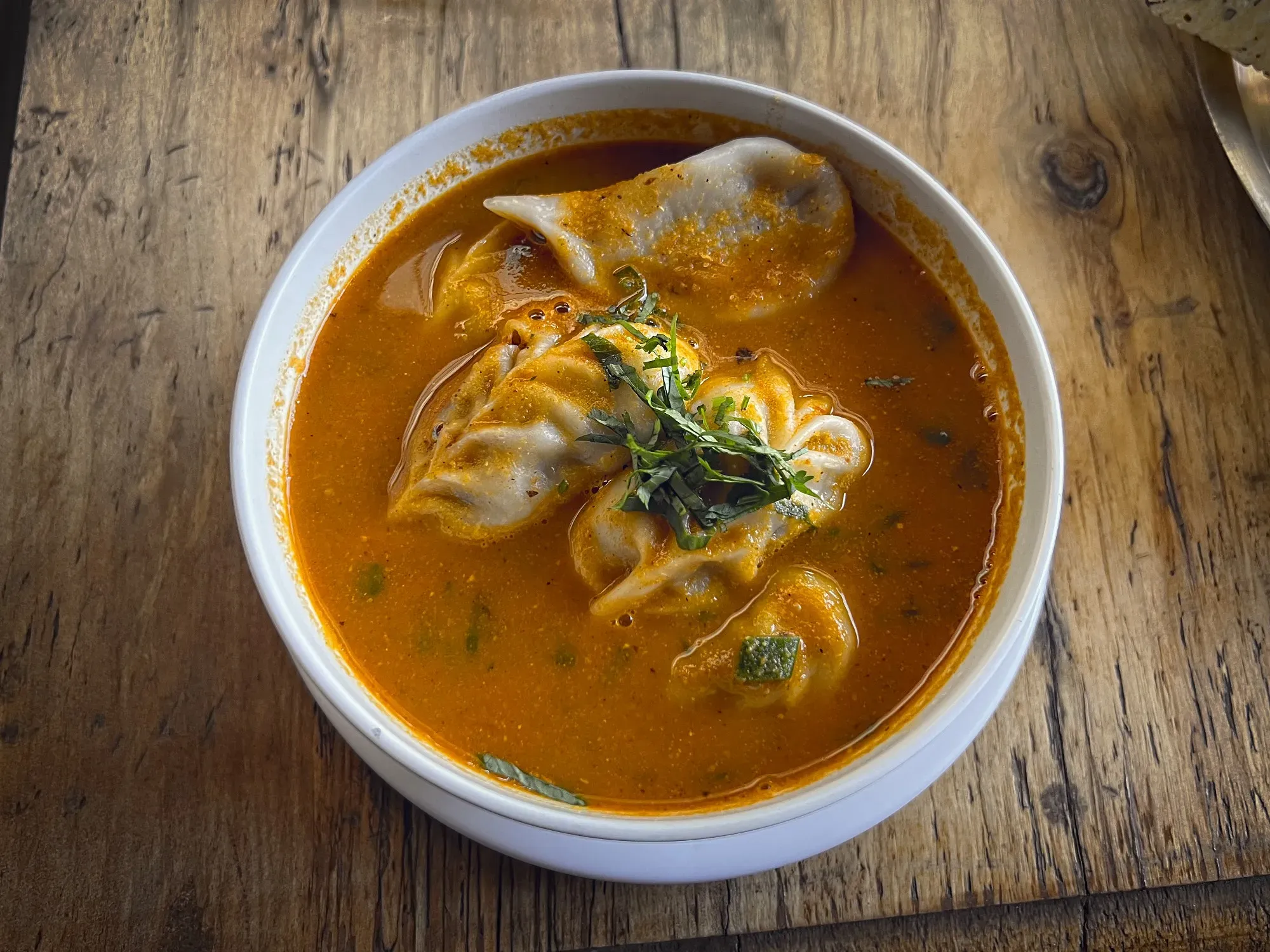
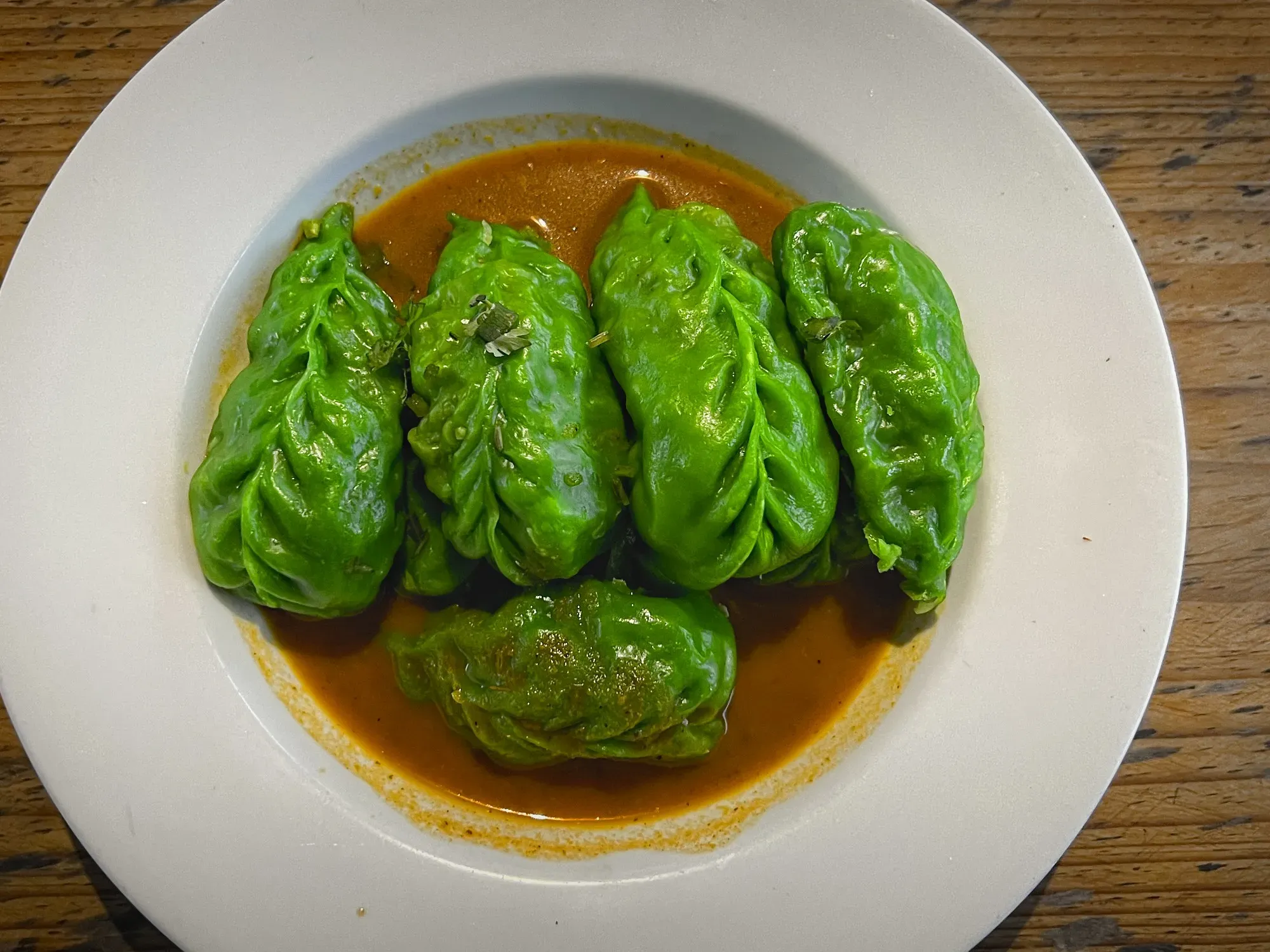
Momo are bite-sized, Nepalese dumplings that have become extremely popular in the Indian subcontinent and around the world. While Dal Bhat is classically considered the national dish of Nepal, due to their rising international popularity Momo are making a strong case for being the "new" national dish of Nepal. There are a few theories on Momo's origins, but the prevailing one is from Newari traders through contact with Tibet. These Nepali traders adapted Tibetan dumpling techniques and created momo. Momo are traditionally filled with water buffalo or vegetables, depending on the region, but today have expanded to include virtually any combination of ground meat, vegetables, tofu, mushrooms, paneer, and chhurpi (yak cheese). In fact, modern restaurants even make dessert Momo nowadays.
Momo is typically served alongside dipping sauces/chutneys. The most popular types of chutneys are tomato-based and peanut/soybean-based (called Jhol acha) sauces. To add even more variety to the diversity of Momo, Momos can also be served in a few different ways:
- Steamed
- Kothey style- pan-fried on one side
- Fried
- Soup momo/mok-thuk- Tibetan style, where the dumplings are cooked and served in a soup
- Chilli style- steamed dumplings served in hot sauce
- Jhol style- steamed dumplings drowned in the Jhol acha sauce infused with Timur/Sichuan pepper
Thukpa
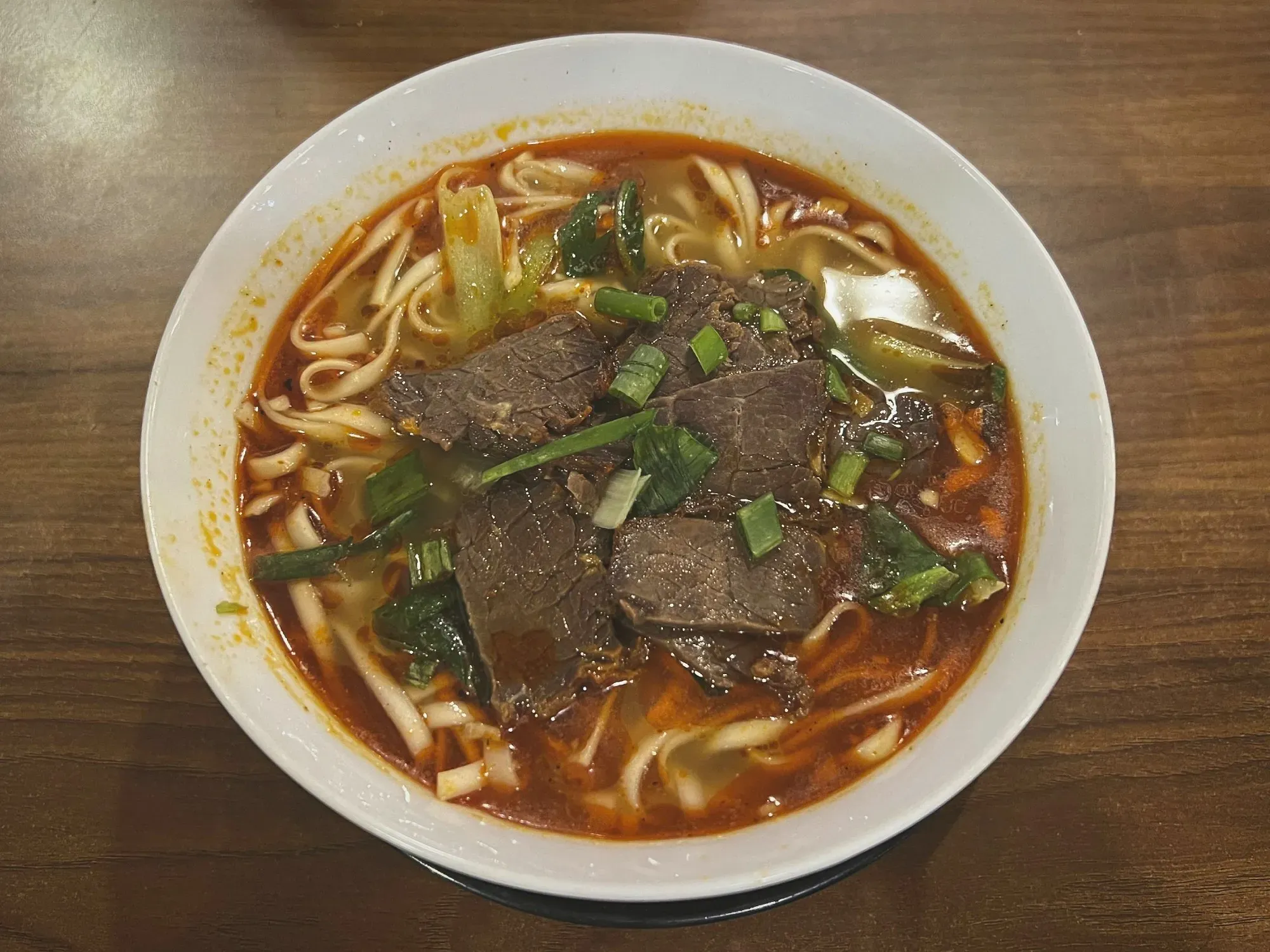
Thukpa is a Tibetan and Nepali noodle soup. Thukpa originated from Tibet, and over the years has evolved with various cultures to form numerous varieties. Tibetan Thukpa styles include: Thenthuk, Gyathuk, Thugpa (pinched noodle - think gnocchi), and Drethug. The Nepalese version of Thukpa is technically Thuppa, although the Nepali people refer to their version of the dish as simply Thukpa when in Nepal.
Nepalese Thukpa takes the Tibetan classic and adapts it by adding a decent bit of spice to the broth and coriander leaves as garnishes. Nepalese Thukpa also is more commonly vegetarian, adding a bean or legume as a protein source. However, egg or buffalo are also common Nepalese Thukpa variations.
Regional-Specific Shoutouts
Newari Khaja (aka, Samay Baji)
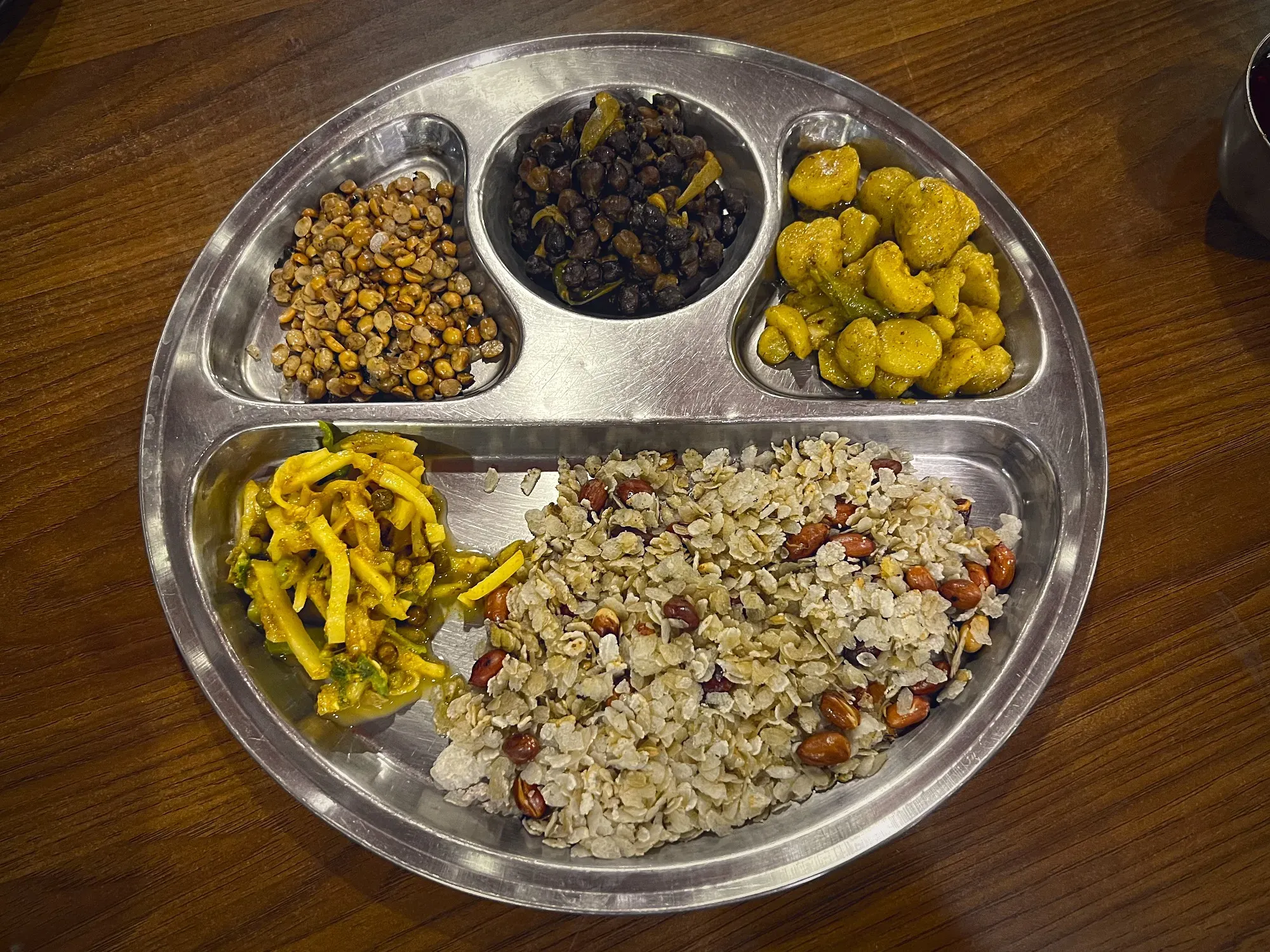
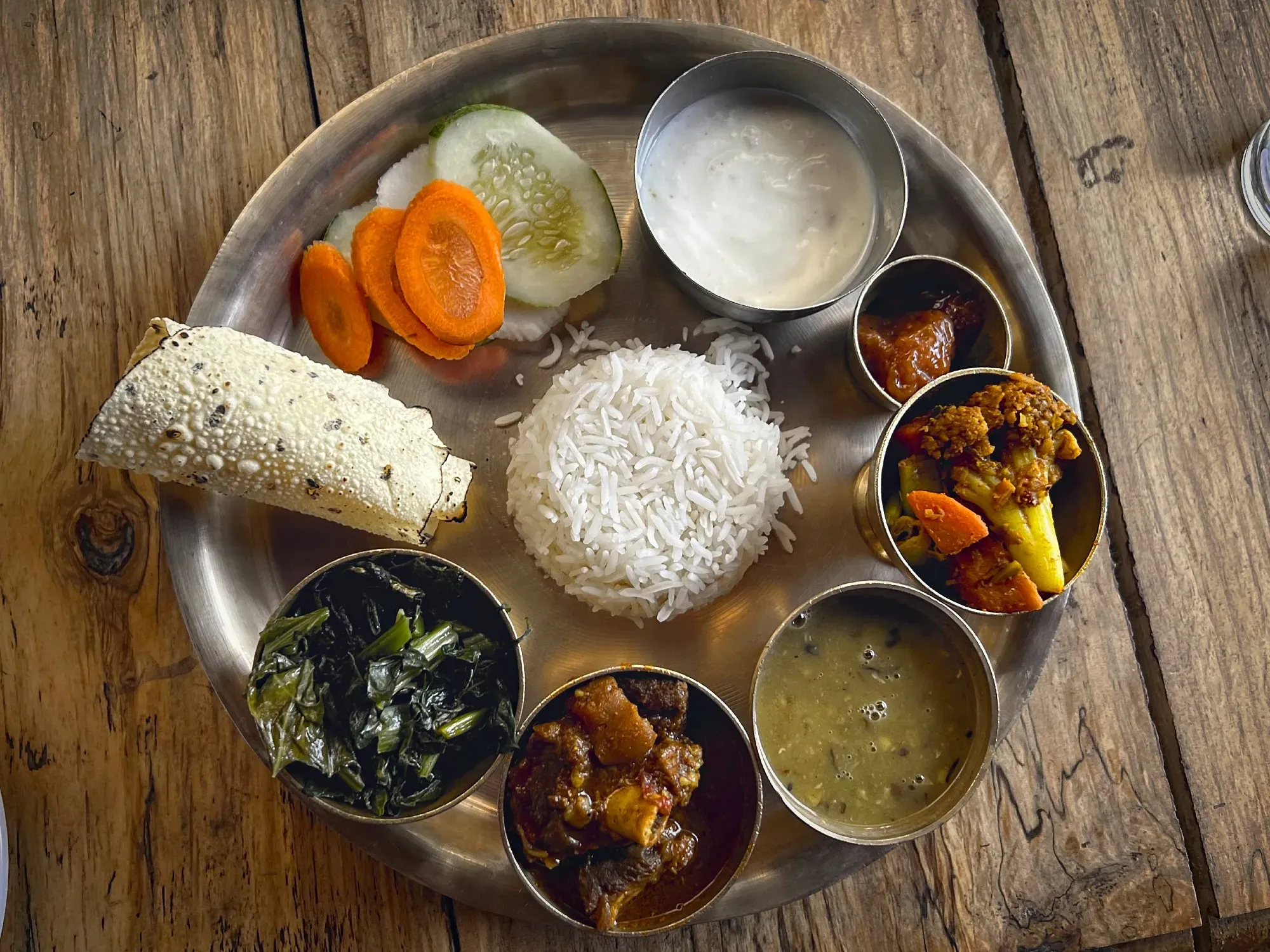
Newari Khaja, also known as Samay Baji, is a set of Newari snacks and small dishes served together on a platter. It is a fantastic display of the highlights of the Newar cuisine all in one meal. The Newari community of Nepal are one of the main people groups in Nepal who have been living in the Kathmandu Valley for centuries. The dish arose from the community's farmers who would prepare meals that could be eaten throughout the day without the need to do much heating or recooking.
The set is made of some of the following:
- Chuira (flattened rice)
- Chhoyela/Chwela (barbecued buffalo)
- Musya (roasted Bhatmas- black soybeans)
- Gundro (fermented mustard leaves)
- Bodi ko Achar (boiled, pickled beans)
- Alu Sandeko/Tama/Tarakari (potato salad/soup/curry)
Gundruk
Gundruk is a traditional Nepalese food that is made by fermenting leafy green vegetables such as mustard greens or spinach. The vegetables are soaked in water for several days, then sun-dried and compressed into small balls or flattened cakes. The dried Gundruk can be stored for several months and is used in soups, stews, and curries.
The origin of Gundruk can be traced back to the hilly regions of Nepal, where it is a popular food item. It is often considered to be a staple food in Nepalese cuisine, as it is rich in nutrients and can be stored for long periods of time.
Gundruk has a unique sour flavor and a slightly crunchy texture, which adds depth to dishes that it is used in. It is often paired with other traditional Nepalese foods such as dal bhat and is also considered to have medicinal properties.
Sel Roti
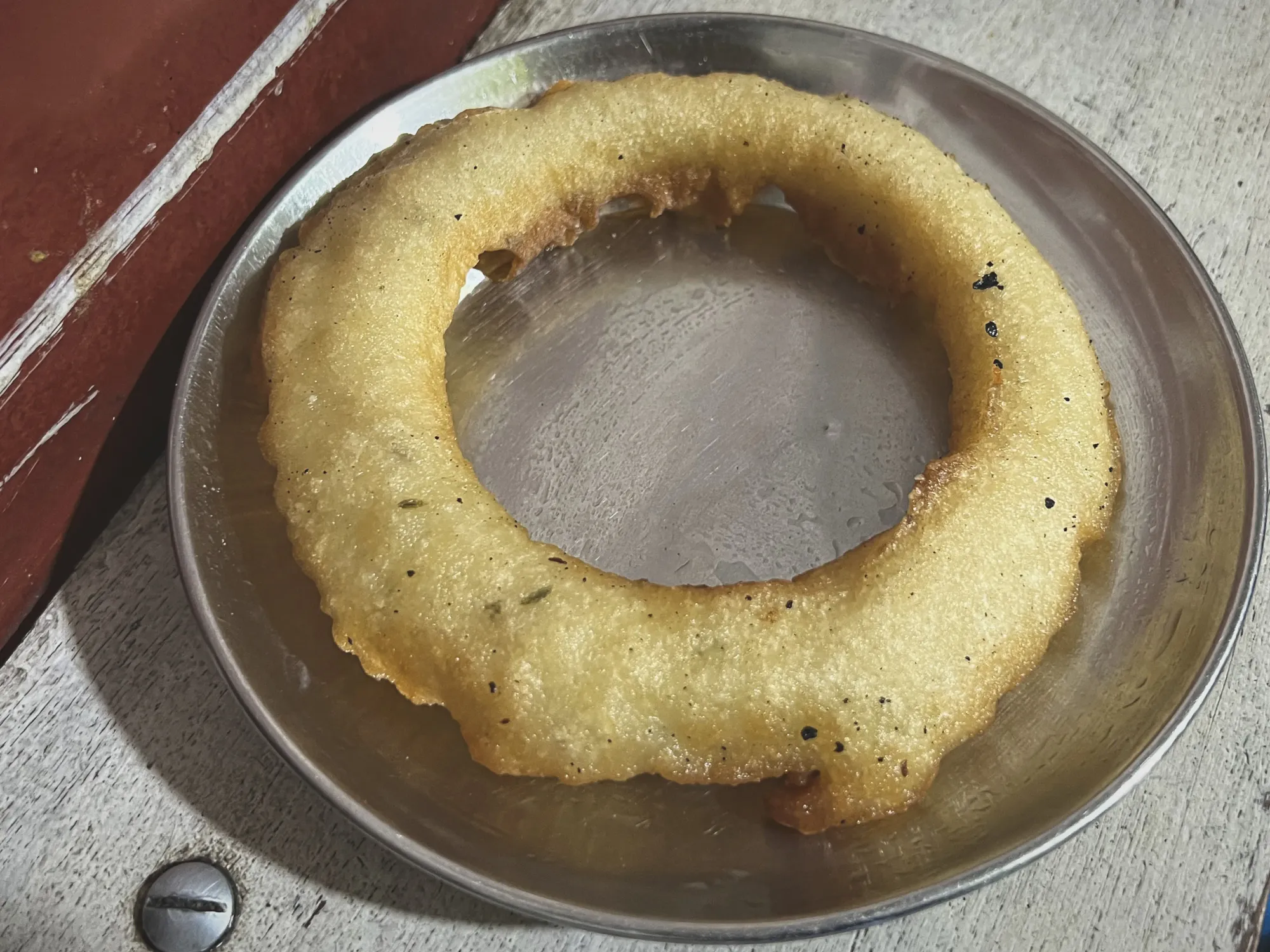
Sel Roti is a traditional Nepalese sweet snack that is made from a rice flour batter. The batter is poured through a funnel into hot oil and deep-fried to form a circular shape with a crunchy exterior and a soft, chewy interior. It is often flavored with cardamom or other spices, and can be served on its own or with a cup of hot milk tea.
Sel Roti is often prepared during festivals and special occasions such as weddings, and is also sold by street vendors throughout the country. Sel Roti has become a symbol of Nepalese culture and tradition, and is enjoyed by people of all ages. Its unique texture and sweet flavor make it a popular treat for both locals and tourists, and it is often included in gift baskets and food hampers during festive seasons.
Wo or Bara
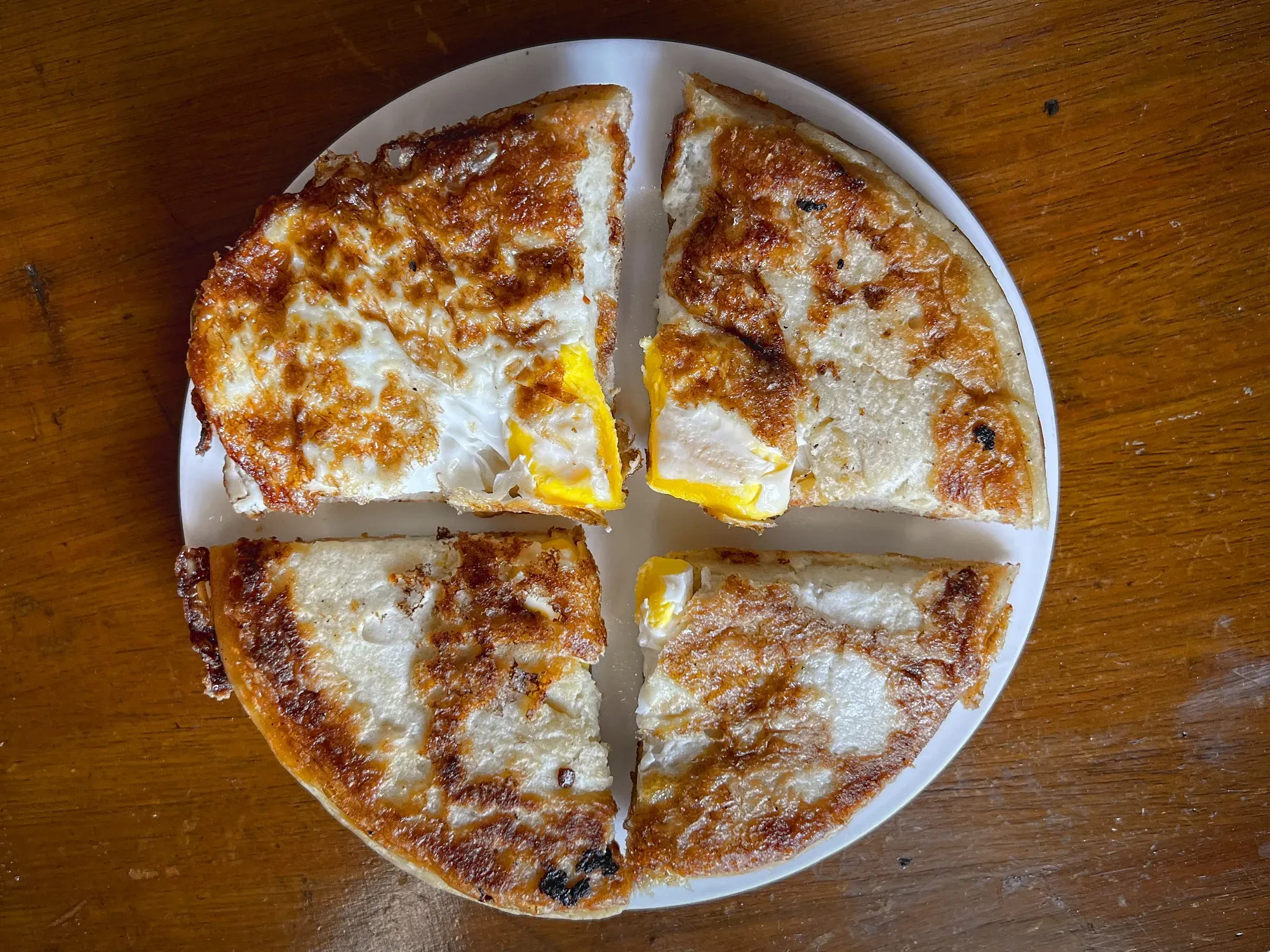
Wo, also known as Bara, is a traditional Nepalese dish that is made from a lentil flour batter. The batter is seasoned with cumin, ginger, and other spices, and is then fried to create a savory pancake-like dish. Wo can be served on its own or topped with a variety of ingredients such as chopped onions, tomatoes, eggs and chilies. The above picture is an egg Bara.
The origin of Wo can be traced back to the Newari community of Nepal, who have been living in the Kathmandu Valley for centuries. It is often prepared during festivals and special occasions, and is also sold by street vendors throughout the country.
Wo has become a symbol of Nepalese cuisine and culture, and is enjoyed by locals and tourists alike. Its unique texture and flavor make it a popular snack and meal option, and it is often paired with other traditional Nepalese foods such as chutney and pickles.
Yomari
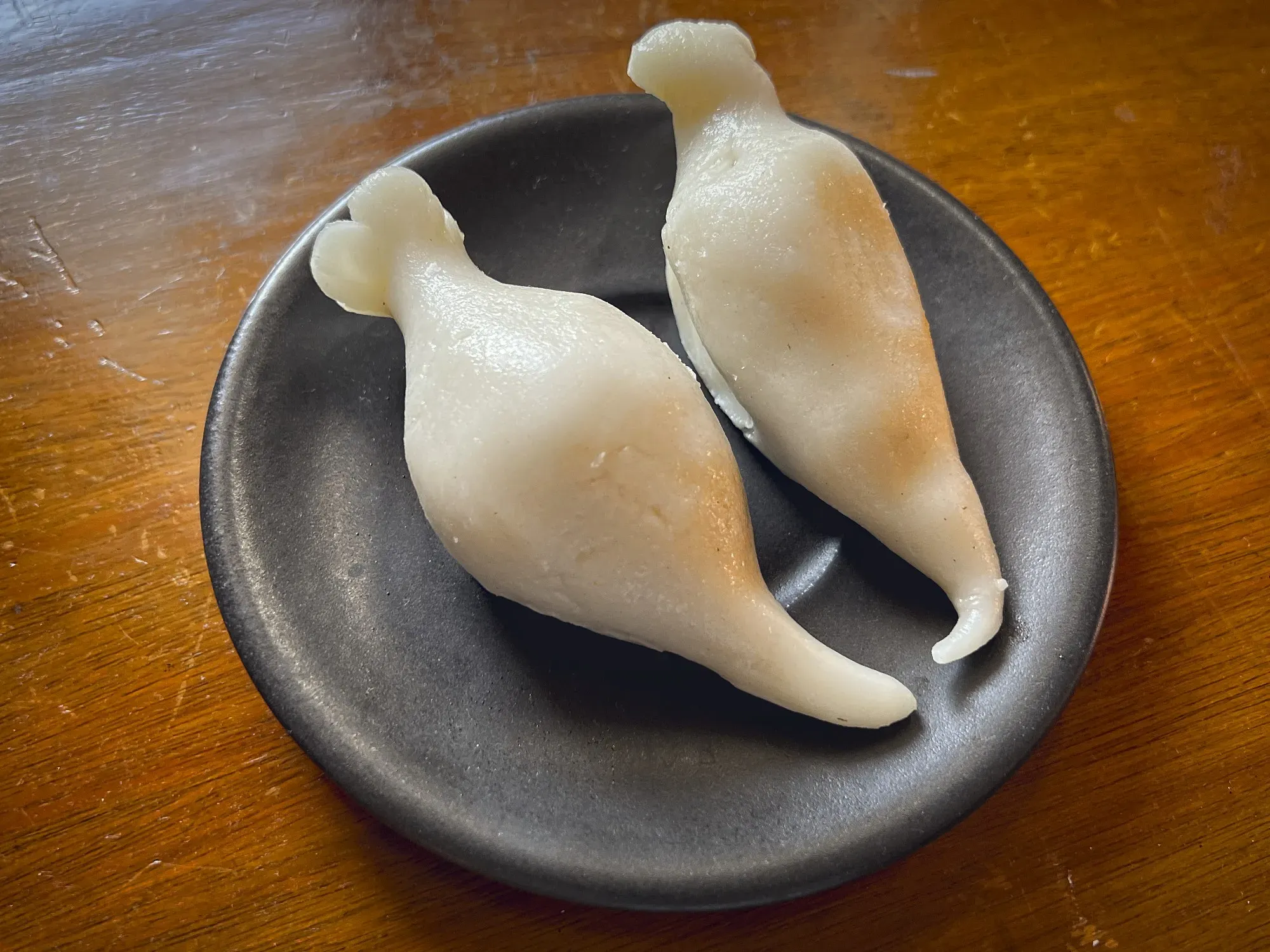
Yomari is a traditional Nepalese sweet dish that is made from rice flour dough filled with sweetened sesame seeds or molasses. The dough is shaped into a pointed oval and steamed, and is typically served with melted butter and a sprinkle of ground cardamom.
The origin of Yomari can be traced back to the Newari community of Nepal. It is often prepared during the Yomari Punhi festival, which is held to celebrate the winter solstice. Its unique flavor and texture make it a popular dessert, and it is often given as a gift during festive seasons.
Dhindho or Dhido
Dhindho, also known as Dhido, is a traditional Nepalese food that is made from buckwheat or millet flour mixed with water and stirred continuously over low heat until it forms a thick, dough-like consistency. It is often eaten with a variety of curries or pickles.
The origin of Dhindho can be traced back to the hilly regions of Nepal, where it is a staple food item. It is often considered to be a simple yet satisfying meal, as it is rich in nutrients and provides a good source of carbohydrates. Its unique texture and flavor make it a popular meal option, particularly in rural areas where it is still prepared in a traditional manner.
Tongba
Tongba is a traditional alcoholic beverage of the Limbu people, who live in the eastern region of Nepal. It is made by fermenting millet and then pouring hot water over it to release the flavors and aromas. The resulting mixture is then drunk through a bamboo straw called a "pangden." Tongba is often enjoyed during social gatherings and is a symbol of Limbu culture and tradition.
Sherpa Stew
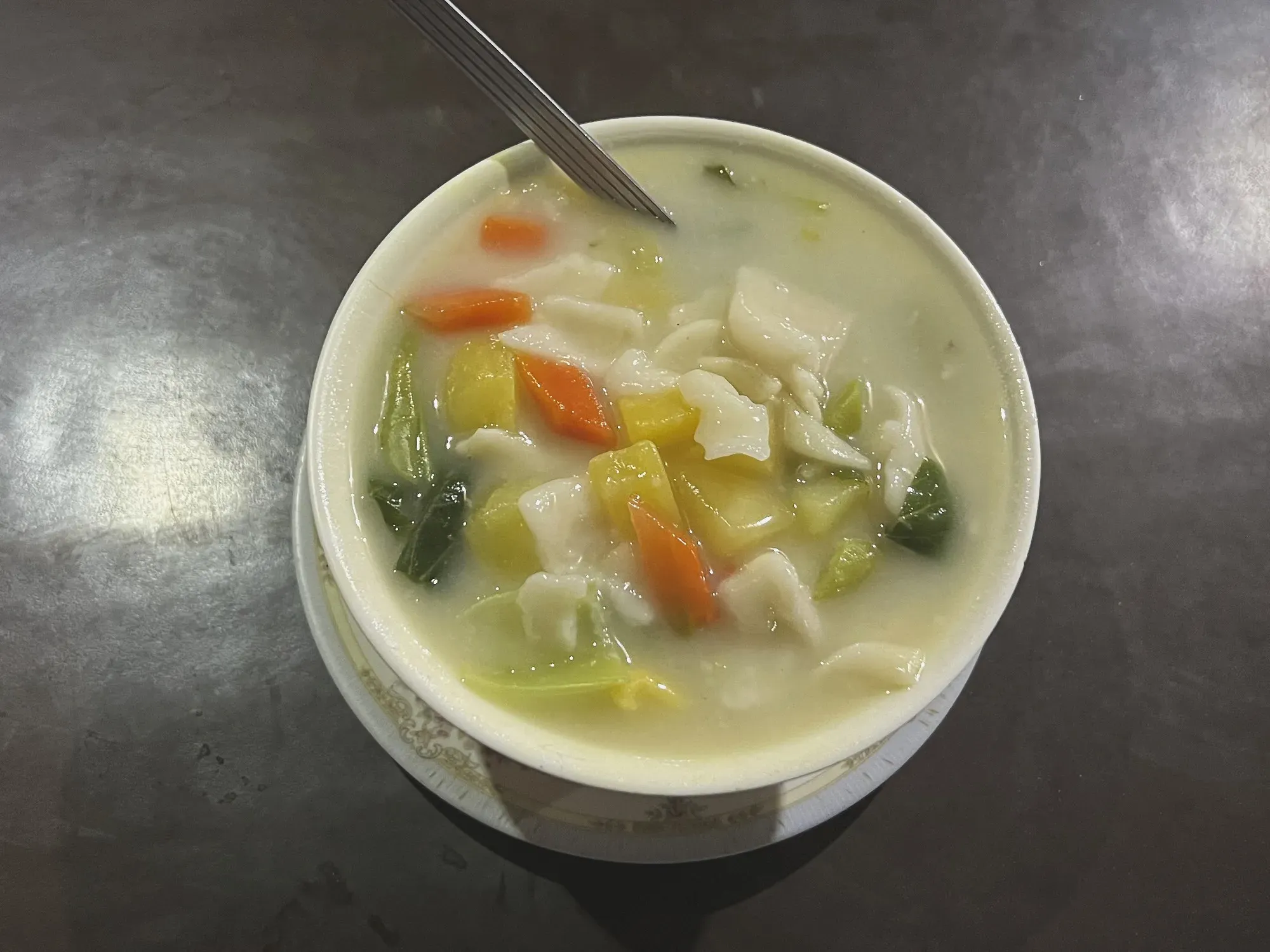
Sherpa stew is the name for a thick, hearty vegetable noodle stew that is commonly eaten by people in the Himalayan mountains. There is no one specific way to make this, and some version will be available at every tea-house in the mountains.
Choila
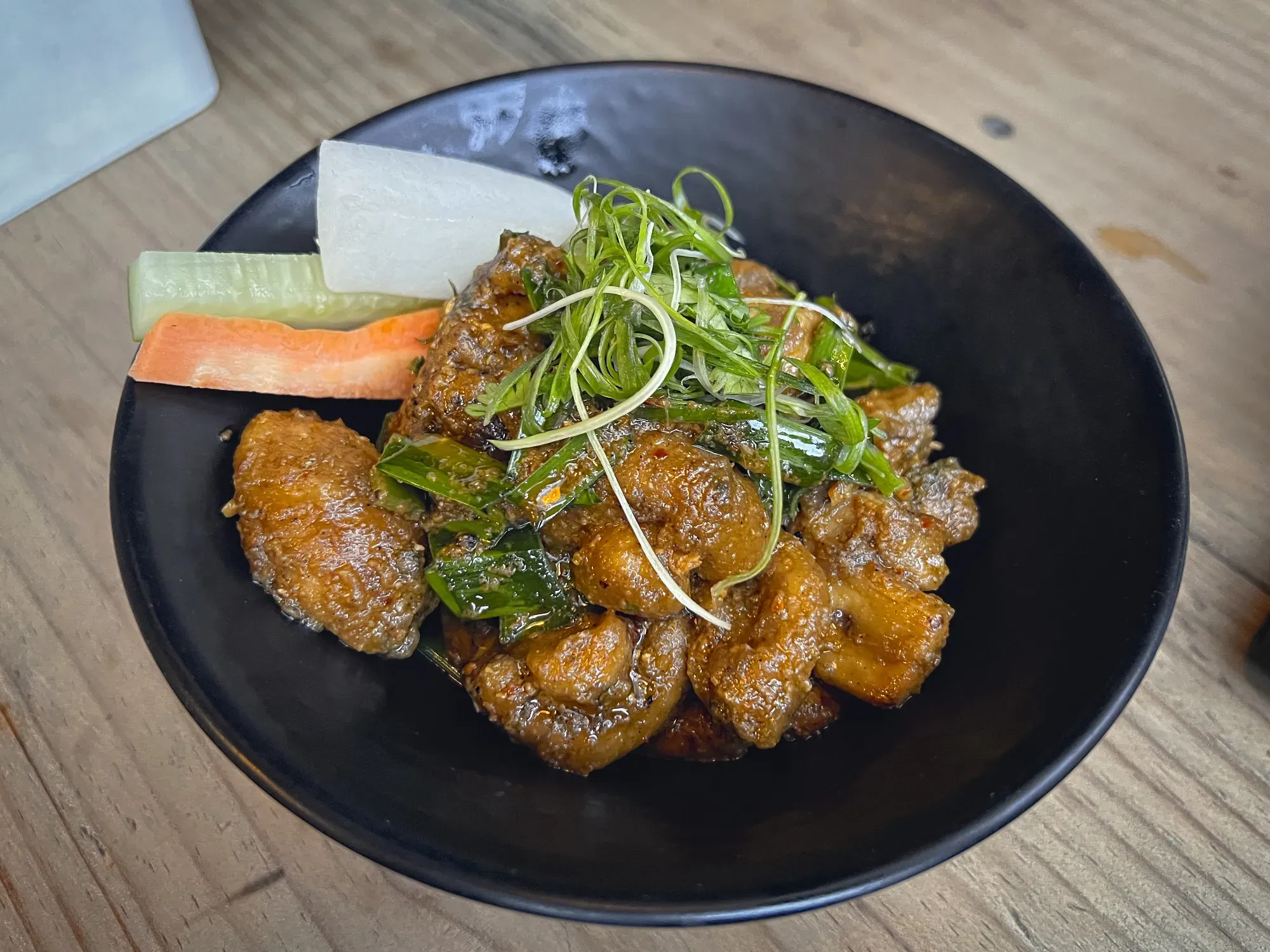
Choila is a spicy dish made from grilled meat or vegetables, typically chicken or buffalo, that is marinated in a mixture of spices and oil. The meat is then diced into small pieces and served cold with beaten rice and a variety of side dishes such as pickles and chutneys. Choila is a popular Newari dish that is often served during festivals and special occasions.
Juju Dhau
Juju Dhau, also known as "king curd," is a special type of yogurt that is made in the Bhaktapur region of Nepal. It is prepared by boiling milk and then adding a small amount of yogurt as a starter culture. The mixture is then left to ferment in earthenware pots for several hours. The resulting yogurt is thick and creamy, with a slightly sweet and tangy flavor. Juju Dhau is often served as a dessert and is considered a delicacy in Nepal.
Chatamari
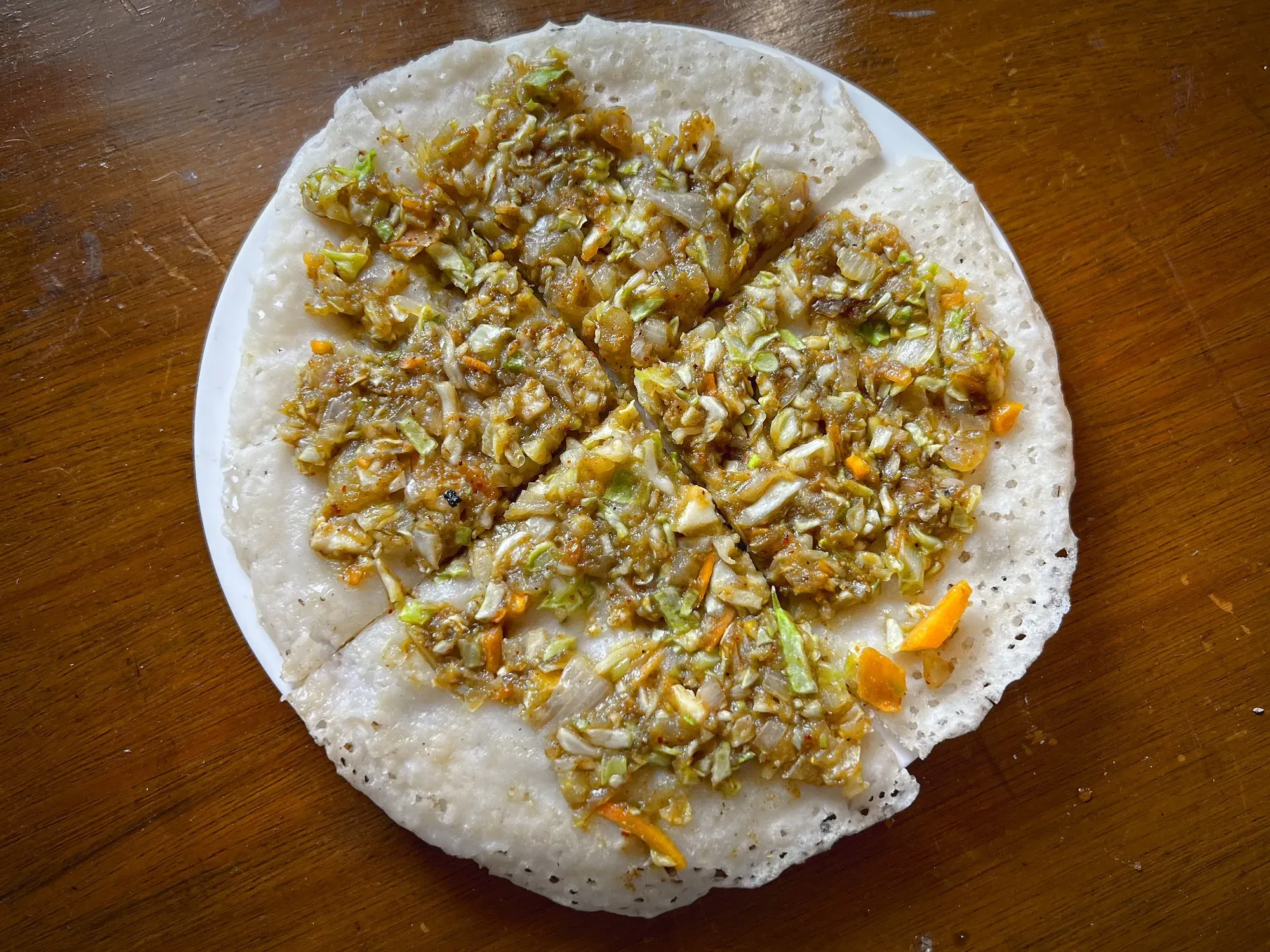
Chatamari is a savory rice flour crepe that is a popular Newari dish in Nepal. It is made by spreading a thin layer of rice flour batter onto a hot griddle and then topping it with a variety of ingredients such as minced meat, eggs, vegetables, and spices. Chatamari is often served as an appetizer or snack and is a symbol of Newari culture and tradition.
Chatpate
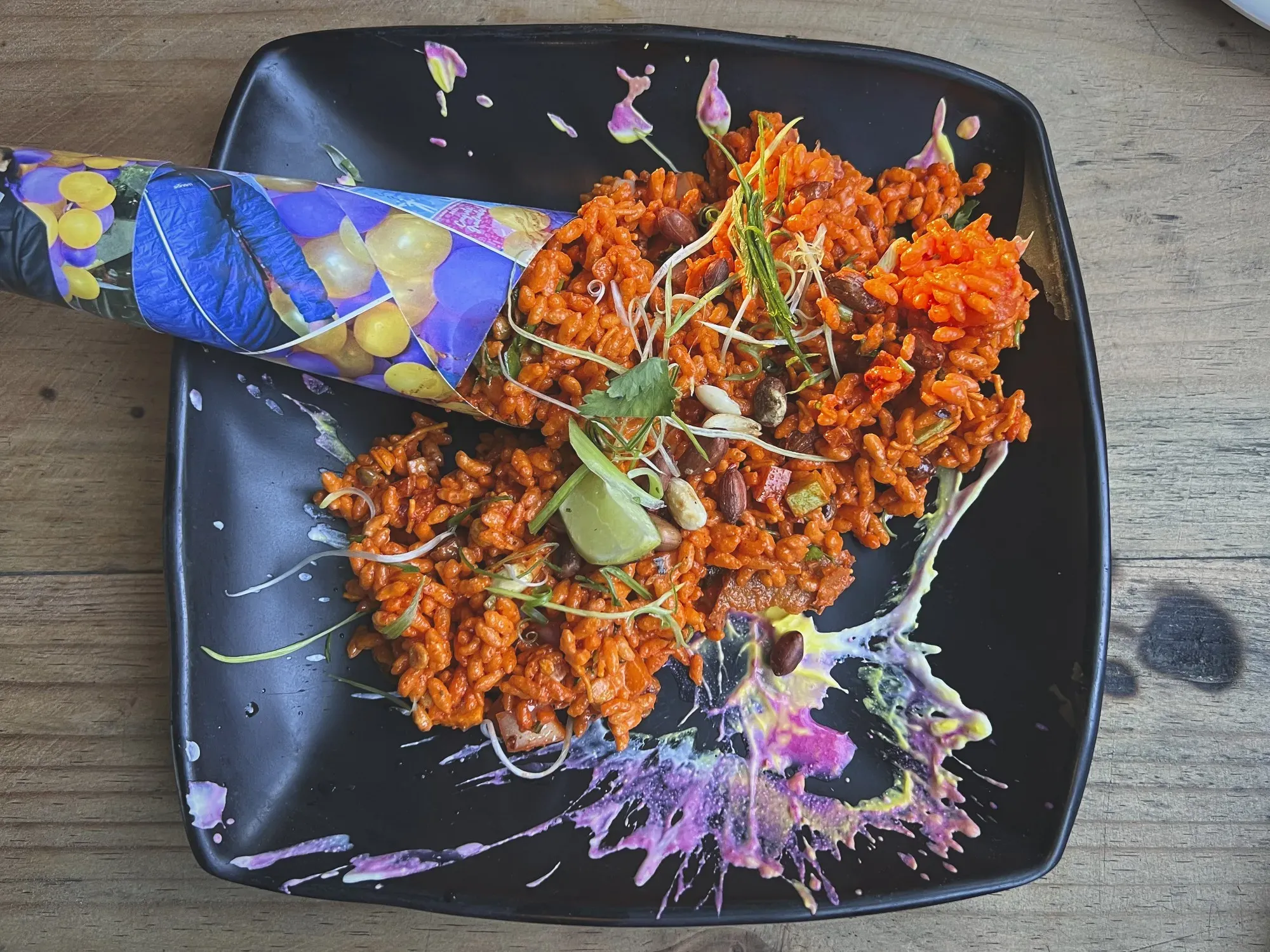
Chatpate is a popular street food snack in Nepal made from a mixture of chopped vegetables such as onions, tomatoes, and cucumbers, along with spices and a tangy tamarind sauce. The mixture is served on a bed of crispy fried noodles or flattened rice and is often topped with a sprinkle of fresh cilantro. It is similar to Indian Panipuri. Chatpate is a quick and easy snack that is enjoyed by people of all ages and is a symbol of Nepalese street food culture.
Kurkure Waiwai Sadheko
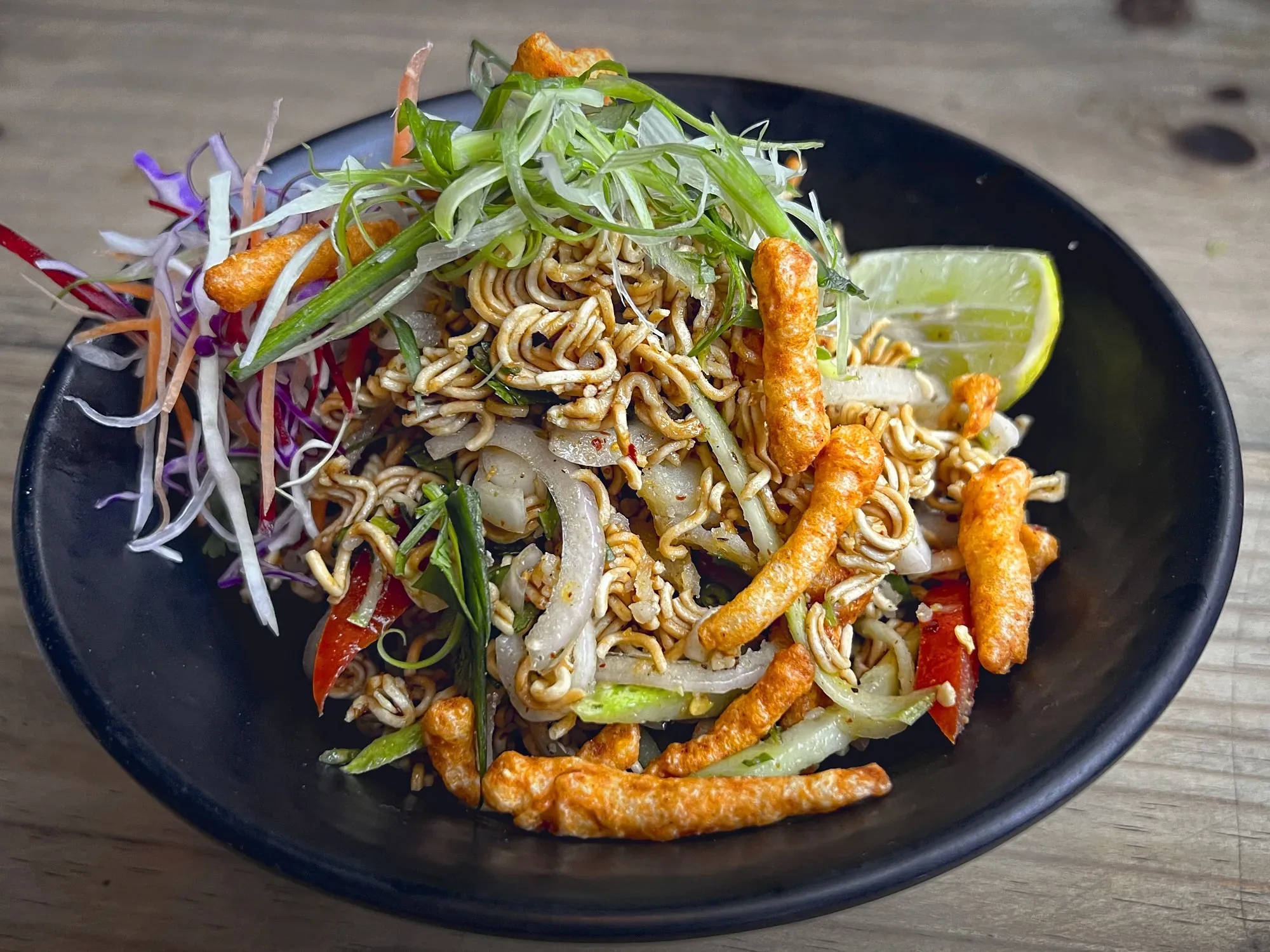
Kurkure Waiwai Sadheko is a spicy and crunchy snack made from the popular Nepalese instant noodle brand, Wai Wai. The noodles are first fried until crispy and then mixed with a variety of spices and seasonings such as chili powder, salt, and cumin. The resulting snack is savory, crunchy, and spicy, making it a popular street food snack in Nepal. Kurkure Waiwai Sadheko is often enjoyed with a cold beverage and is a symbol of Nepalese street food culture.
Thakali Khana
Thakali Khana is a traditional Nepalese meal that originates from the Thakali people of the Mustang region in Nepal. It typically consists of a plate of rice, lentil soup, and a selection of side dishes such as meat curry, stir-fried vegetables, and pickles. Thakali Khana is known for its bold and aromatic flavors, which are derived from the use of spices such as cumin, coriander, and turmeric. This dish could be described as Thakali "Thali" (the internationally recognizable name for the style Indian cooking with many small dishes), and is a popular meal in Nepal. While a similar idea, it is distinct from Newari Khaja.
Laping
Laping is a traditional Tibetan dish that has become a popular street food snack in Nepal. It is made from mung bean starch that is soaked in water, boiled, and then shaped into a gelatinous form. The dish is often sliced into thin strips and served cold, topped with a spicy chili sauce, soy sauce, and vinegar. Laping is believed to have originated in Tibet and was traditionally eaten as a cold dish during the hot summer months. It has since spread to other parts of the Himalayan region, including Nepal, where it is a popular street food snack enjoyed by locals and tourists alike.
List of Other Things to Try:
- Raksi - a distilled spirit made from millet or rice
- Gorkhali Lamb - special lamb dish
- Pau Kwa - sour plum soup
Resources
Restaurant Recommendations
All of the meals we ate in Nepal revolved around Kathmandu and the tea-houses in the Himalayas. There are plenty of restaurants of all kinds in Kathmandu. At least once you should try one of the family-entertainment restaurants that serve a full Newari Khaja. These establishments are definitely designed for tourists and hikers, but are nonetheless a great way to try the Newari cuisine. There are many of these restaurants in Kathmandu- we ate at Gokarna House Restaurant and thought it was solid.
Other standout restaurants in Kathmandu included a modernized Nepalese restaurant set in a back-alley garden called Lavie (Garden). They prepared visually-pleasing dishes with solid quality in a fun, youthful atmosphere. It was a superb place to watch some of the 2022 World Cup games! Finally, Third Eye is a popular Indian restaurant in Kathmandu that was quite fantastic. They provide impressive renditions of the highlights, as well as the best stuffed kulcha I have ever had. I would strongly recommend heading here to gather some calories after hiking.
To see an extensive list of restaurant recommendations in Nepal, check out the Restaurants page to see a map of our top recommendations for Asia as well as the database with details on restaurants from all around the world.







